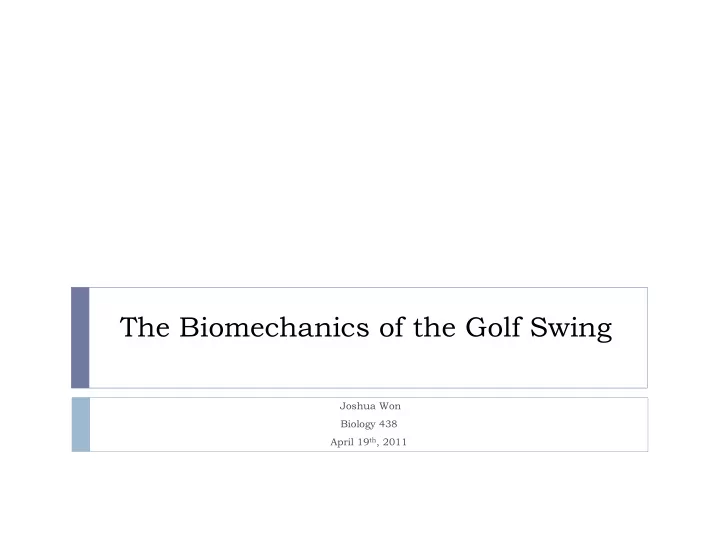

The Biomechanics of the Golf Swing Joshua Won Biology 438 April 19 th , 2011
The Golf Swing The golf swing is a technique the golfer uses to hit the golf ball, hoping (for most) the ball will end up at the designated target. Through instruction and practice, the golfer develops coordinated control of multiple muscle groups to produce a golf swing.
The Ideal Swing
The Study Analyze the components of the golf swing. The muscles involved. Look at the kinetics of the golf swing. How technique can effect the golf swing. The muscles involved. The differences in kinetics.
The Golf Swing Simplified Although the golf swing Swing Plane Angle 2 has many moving Swing Plane Angle 1 Head Position components, I will focus Shoulder Plane primarily on the hip, back, Hip Angle Arm Position leg and shoulder muscles. Spine Angle I will ignore the Knee Flex Angle complicated positions (shown on the left) that setup the swing. “They say golf is like life, but don't believe them. Golf is more complicated than that .” - G. Dickinson
The Muscles Involved
The Muscles Involved Recruitment of fast twitch muscle fibers. Fast contraction time (higher v max ) Greater efficiency at higher velocity. Power more important than economy.
The Backswing The Storing of Potential Energy – Muscle Loading The arms stay in front of the 1. chest as the shoulders turn. The left deltoid, left latissumis 2. dorsi, right rhomboideus major and left teres major are extended at the top of the swing. The hips create tension in the 3. back by restricting rotational movement. (creating torque)
The Down Swing The Release of Potential Energy – The Kinetic Chain The left knee opens to the right forcing 1. the hip to follow. The opening of the hips turns the 2. shoulders with the arms. Once the club reaches the ball the left 3. hip muscles, left quadricep are fully contracting. The shoulders and back muscles are 4. isometrically contracting to create resistance to allow the hands to move past the chest, freely, accelerating the club through the ball. The club momentum carries throughout 5. the swing, which ends at the follow through.
Force The club is moving in a circular motion. So at impact, F centripetal = mv 2 /r v impact = 39.8 m/s m club = 270 grams r = 1.36 m F centripetal = (.270)(39.8) 2 /(1.36) = 314.5 N
Energy K.E. = (1/2)mv 2 (assuming the club is moving in a linear path at impact) m club = 270 grams v impact = 39.8 m/s K.E. = (1/2)(0.270)(39.8) 2 = 213.8 J
Power From the start of the back swing to the end of the down swing. Power = W/∆t W = 213.8 J t = 0.683 s Power = (213.8)/(0.683) = 313 watts
Momentum m club = 270 grams v impact = 39.8 m/s Momentum at impact = mv impact (0.270)(39.8) = 10.7 kg*m/s Impulse impact = change in momentum F∆t = m∆v (314.5 N)(0.278s) = 87.4 N*s
Arm vs. Full Body Swing Most inexperienced golfers attempt to hit the golf ball with only their arms. This swing is inefficient and difficult to reproduce. The arms have too much control of the swing which leads to inconsistent ball strikes. The full body swing recruits bigger muscles to produce the swing. Less control in the arms (greater consistency). Greater club head speed with minimal effort.
The Arm Swing The T echnique The Muscles Involved Using your dominant hand, Primary Muscles – Biceps pull the club back and and forearm muscles push it through the hitting (supinator and flexor carpi area. ulnaris) The opposite hand is used to stabilize the club during the swing.
The Arm Swing
The Full Body Swing The T echnique The Muscles Involved For this swing, use your shoulders, back, hips and legs to coordinate the movement. The arms stay in front of the chest as the rest of the body turns.
The Full Body Swing
Comparison Arm Swing Full Body Swing Vel. club at impact (m/s) 32.3 39.8 Force at impact (N) 228.3 314.5 Energy at impact (J) 140.8 213.8 Power (W) 230.1 313.0 Momentum (kg*m/s) 8.7 10.7 Ball Speed (after impact) 50.2 72.4 (m/s) *Data for calculations acquired on logger pro.
Conclusions The full body swing produces more force and energy than the arm swing. The full body swing generates greater ball speed, which is important for the golfer. The full body swing is more efficient. The amount of energy produced in the full body swing is created by 4 muscle groups instead of 2. The arm swing relies on 2 muscle groups, both which are smaller than any of the 4 muscles in the full body swing.
Forward Directions In the future, I would like to analyze the difference in club velocity between relaxed vs. tense muscles. Based on muscle fiber force vs. velocity curves, muscle fibers can generate higher velocity with less force. As we saw in the data, club head velocity is most important for create higher energy. Also, obtain readings from an electromyogram during a golf swing to see, in real time, individual muscle activity.
References "Kinetesis Sports » Blog Archive » Understanding The Golf Swing." Kinetesis Sports Solutions Specializes in Golf Fitness, Exercise, and Flexibility Programs to Help Golfers Improve Their Swing and Prevent Injuries . http://kinetesissports.com/blog/?p=203 Kao, J. T., M. Pink, F. W. Jobe, and J. Perry. "Electromyographic Analysis of the Scapular Muscles During a Golf Swing." The American Journal of Sports Medicine 23.1 (1995): 19-23. Print. Adlington, GS. "Proper Swing Technique and Biomechanics of Golf." Clinical Sports Medicine 15.1 (1996): 9-26. Print. Logger Pro ver. 3.8.3
Recommend
More recommend